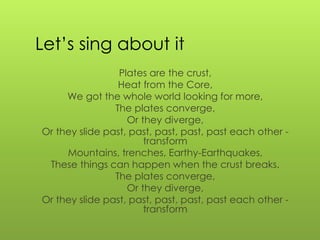Plate boundaries ppt
- 2. What are tectonic plates? Plate tectonics is the theory that Earth's outer shell is divided into several plates that glide over the mantle, the molten rocky layer above the core. Plates move only 1-10 centimeters per year
- 3. How do the plates move? Tectonic plates interact at locations called plate boundaries There are three types of movement at plate boundaries
- 4. Three Basic Types of Plate Boundaries Divergent Convergent Transform USGS Graphics Using hands to show relative motion
- 5. What happens to the land where the plate boundaries move? Convergent boundaries are where plates collide - Mountains, earthquakes, and volcanoes form where plates collide.
- 6. What happens to the land where the plate boundaries move? Places where plates are coming apart are called divergent boundaries. Rift valleys and ocean ridges form at these boundaries
- 7. What happens to the land where the plate boundaries move? Places where plates slide past each other are called transform boundaries. The sliding motion causes earthquakes.
- 8. Let’s sing about it Plates are the crust, Heat from the Core, We got the whole world looking for more, The plates converge, Or they diverge, Or they slide past, past, past, past, past each other - transform Mountains, trenches, Earthy-Earthquakes, These things can happen when the crust breaks. The plates converge, Or they diverge, Or they slide past, past, past, past, past each other - transform







